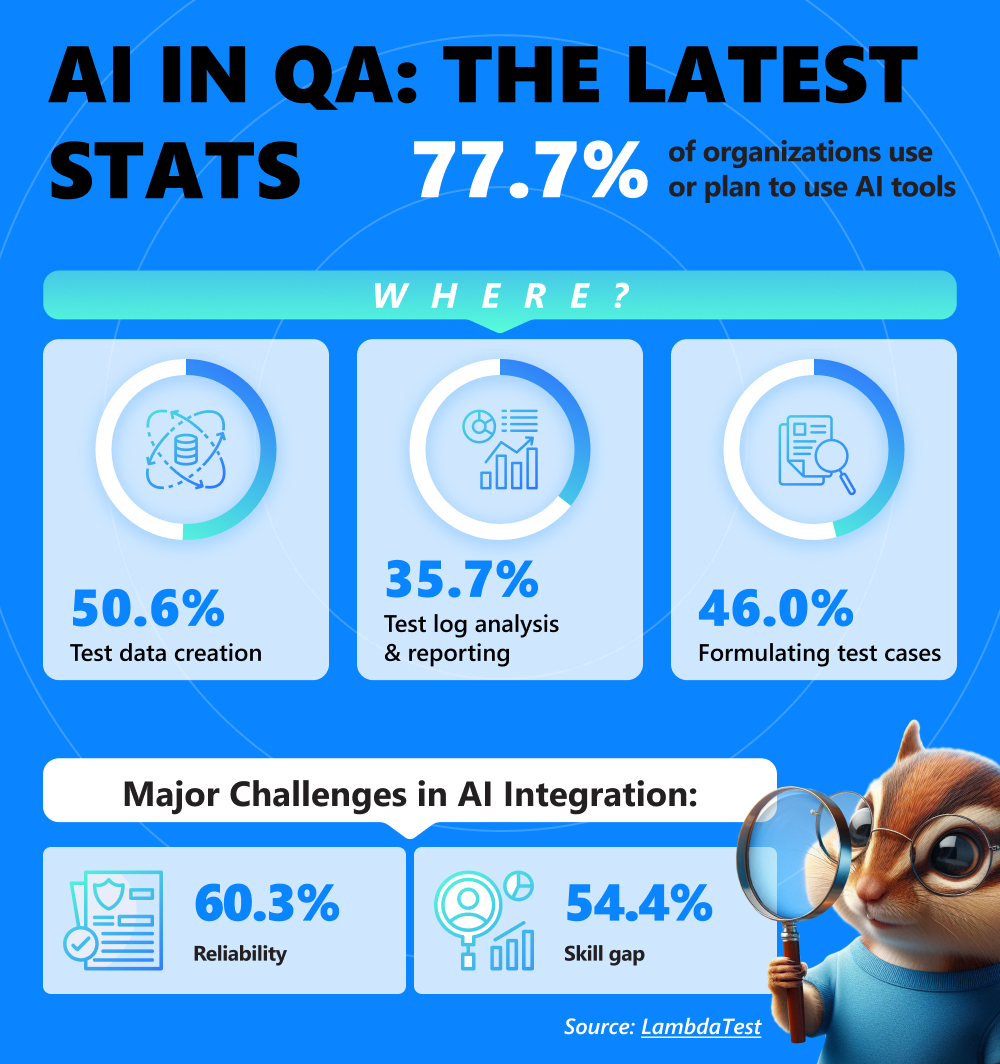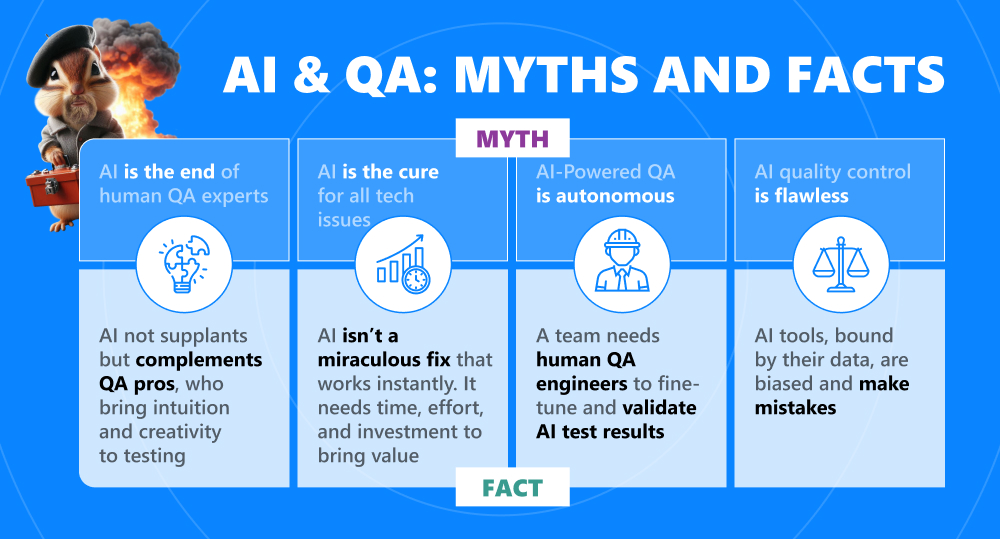AI, QA, testing… Once these terms seemed to belong to different tech galaxies. Can they go together these days? After all, when this trinity pops up in a conversation, it ignites fiery debates: “Can AI completely replace human testers? Is AI testing error-free?” What are these — myths that AI enthusiasts revel in, or the truth that testers crave?
Let's get to the bottom of this mystery. If artificial intelligence can speed up your work and do it just as efficient as humans do, then it's worth the investment, right?
written by:
Alexey Rakitsky
Test Automation Manager
AI, QA, testing… Once these terms seemed to belong to different tech galaxies. Can they go together these days? After all, when this trinity pops up in a conversation, it ignites fiery debates: “Can AI completely replace human testers? Is AI testing error-free?” What are these — myths that AI enthusiasts revel in, or the truth that testers crave?
Let's get to the bottom of this mystery. If artificial intelligence can speed up your work and do it just as efficient as humans do, then it's worth the investment, right?
Contents
Meet AI in Quality Assurance
Quality assurance and test automation tools have long been the dynamic duo of the software development process. Yet, the advent of AI has breathed new life into this partnership.
Think where AI has already left its mark. Let’s take graphic design: those perfect lines and textures on the billboard by your favorite restaurant? Likely drawn by a machine. Ever visited that restaurant’s website and talked to a welcoming chatbot? That’s AI in action! Now, look at your smartphone. There’s a gallery of apps where human creativity meets machine intelligence — in brainstorming, design, and execution. And what about testing? An AI assistant probably played a part in perfecting those apps.
This raises a key question: are we trying to prove that robots are taking the lead in every routine? Even manual tests?
Let's turn to the numbers:
Myths vs. Reality: Where Is the Truth?
The ascent of AI in software testing (and across industries) is a global phenomenon, poised to affect most economies worldwide. The projections are staggering: PWC forecasts that AI could inject as much as $15.7 trillion into the global economy by 2030, surpassing the combined economic output of China and India. Amidst this backdrop of immense potential, it's only natural for myths to arise. How about separating fact from fiction to objectively assess AI potential for QA teams?
Myth #1. AI Is the End of QA Experts
Testers are haunted by the thought that AI will replace them all one day. With tech giants laying off staff, the fear seems tangible. But is there a real threat, or can testers sleep peacefully (at least for now)?
Truth: AI outshines in automating mundane tasks and enhances the efficiency of testing processes. But it falls short of replicating the nuanced expertise, critical thinking, and problem-solving that QA professionals offer. The machine complements, not supplants. Context, intuition, and creativity remain uniquely human strengths that are yet beyond the reach of AI test automation tools.
Myth #2. AI Quality Control Is Flawless
One of the biggest illusions of a QA tester is that AI and machine learning techniques can handle the entire testing process alone. But the real question is, what’s more effective? Using minimal AI or fully embracing smart testing tools?
Truth: The dream of error-free automated tests is just a dream. The reality bites: relying solely on AI for quality control is like expecting a GPS to guide you through a dense forest without hitting a single tree. AI tools, bound by their data, carry inherent biases and can't notice hidden meanings or understand nuances of test scripts the way a human can.
Myth #3. AI-Powered QA Is Autonomous
Imagine: you're deep in testing, coffee in hand, and you trust AI with your data, stepping out for a breath of fresh air. In half an hour, you're back, expecting a magical transformation. And there it is — a detailed report on your screen along with recommendations on how and what should be fixed. Can AI deliver such perfection independently?
Truth: AI algorithms are trained using historical data and patterns, but they lack the autonomy to decide or act alone. It's the human QA engineer who fine-tunes and validates AI test results, ensuring the machine's smooth operation.
Myth #4. AI Is the Cure for All Tech Issues
Consider this alarming data gathered by Quettra: the average app loses over 95% of its new users within 90 days. Even the top 10 Google Play applications see nearly half their user base churn in three months. The reason? 67% of consumers cite bad experiences.
Amidst this churn crisis, the thought that AI could be the silver bullet for such critical issues as app performance and user retention is tempting. However, this is just a myth.
Truth: The reality is that AI isn't a miraculous fix. It requires significant time and manual effort to train models effectively. The machine's powers are often overstated. Business leaders tend to ignore the need for substantial investment and iterative development required to fine-tune AI algorithms. The machine can certainly aid in detecting patterns and predicting issues that may lead to user drop-off, but it's not equipped with a “magic cure” for bugs.
Getting Pragmatic: How to Use AI in QA & Testing
Myths dispelled and the truth revealed. AI turned out a real dark horse, didn't it? Yet, you still shouldn't let your guard down before bringing new tech into your workflow. First, let's explore use cases where QA & testing with AI can take some weight off your team's shoulders, and then consider a few practical strategies for its implementation.
When to Use Artificial Intelligence in Quality Control
Type
Description
Software test automation
AI-powered tools can scan tons of test data and detect patterns that would be difficult or even impossible for human testers to notice.
Predictive analytics
By examining historical testing data, AI predicts potential defects and high-risk areas in software development projects.
Automated test case creation
The technology can automatically generate test cases based on standardized formats and coding best practices.
Defect diagnosis
By analyzing logs, stack traces, and other relevant data, AI-powered tools can quickly address issues.
User experience analysis
To deliver a superior end-user experience, the machine scrutinizes their behavior and feedback.
How to Befriend AI and QA & Testing
Assign the Right Tasks to the Right Executors
AI excels when it comes to crunching numbers and doing the same thing over and over. But let's face it, AI won't win any awards for creative thinking — that's human territory. How to find the balance? It's all about playing to each other's strengths.
Think of AI as the perfect assistant for meticulous tasks. It's ideal for autonomous testing or data analysis, where it can run thousands of test cases without breaking a sweat or dig through mountains of data to find patterns we'd miss. But when you face a complex problem or need to explore uncharted territory in software testing, your human team should take center stage.
Keep Your Software Testing AI Up-to-Date
Ensuring your AI tools in software testing remain sharp and savvy means more than just occasional check-ins. It's about regularly updating the algorithms and datasets — the core components of your AI system. Keep up with the latest tech advancements so that your digital companion is always ready to tackle whatever new obstacles and demands come its way.
But don't stop there. Team up with your AI squad to pinpoint areas of continuous testing where the machine can add more value to the quality control processes. When you sync AI with your testing routines, you're not just tuning the system — you're turbocharging it.
Fuel AI Only with Quality Training Data
What's another surefire strategy to sharpen your AI's knowledge base? Feed it exclusively with top-tier data. It will serve as the foundation for both artificial intelligence algorithms and the quality assurance process.
Start by sourcing diverse and relevant training datasets. They should mirror the full spectrum of real-world scenarios and anomalies your AI may bump into, fostering its growth and adaptability.
You can also consider using data labeling tools, which can instantly transform raw data into AI-ready fuel. Here are some popular options:
- Amazon SageMaker Ground Truth;
- Label Studio;
- LabelBox;
- Playment;
- Superannotate.
Strategize Your Investment in AI for QA & Testing
Before you jump into quality assurance with AI, take a strategic pause to assess your current testing ecosystem: identify areas where artificial intelligence can pack a punch. Is it boosting test coverage, refining test maintenance, or speeding up test execution?
Once you've mapped out your needs, it's time to search for AI solutions that are cut out for the job. But don't just grab any shiny new tool off the shelf. You need to weigh in on factors like:
- Scalability — can it grow along with your demands?
- Ease of integration — how seamlessly will it blend with your current setup?
- Predictive power — can it help you foresee and navigate the testing road ahead?
Seek out AI tools that come loaded with features promising to make your testing smarter, not harder:
- Intelligent test case generation, conjuring up a variety of scenarios;
- Anomaly detection with a hawk eye for irregularities;
- Proactive issue forecasting to get a leg up on potential obstacles.
Top AI Tools for QA & Testing
What go-to solutions do testers count on for wrangling AI, machine learning, and chatting with computers?
Applitools
Applitools is a visual testing and monitoring platform. Its major goal is to help testers ensure their apps look and function perfectly on all devices and browsers. It's powered by Visual AI that can spot which code changes are more likely to cause bugs and which will lead to the desired outcome. In other words, Applitools captures all those tiny details in an app's UI that even the sharpest human eyes might miss.
Key application:
Test automation & visual testing
Main features:
- Test creation, validation, execution, and analysis;
- UI testing;
- Web, mobile, and document QA;
- CI/CD integration.
SauceLabs
SauceLabs provides a comprehensive suite of testing solutions designed mainly for enterprise software engineering and product teams. It's perfect for optimizing the entire software lifecycle, from development to post-release. SauceLabs provides deep insights into your project's workflow, allowing teams to identify and fix issues swiftly, thereby accelerating the time-to-market for apps.
Key application:
Cross-platform & cross-browser testing solutions
Main features:
- Web and mobile testing;
- Test automation and CI/CD integration;
- Low-code and visual QA;
- Proactive error reporting;
- AI-led quality assurance of APIs.
TestCraft
TestCraft offers a codeless testing environment, enabling organizations to deliver high-quality digital experiences rapidly and efficiently. Its key feature is the ability to create and execute tests without coding, significantly reducing maintenance efforts thanks to its adaptive AI/ML technology.
Key application:
- Selenium-based automated testing
Main features:
- Codeless quality assurance;
- AI- and ML-driven automated test scripts;
- Accessibility tests;
- Cloud-based platform for collaborative testing.
Katalon
Katalon provides a unified AI-augmented platform for testing web, mobile, API, desktop, and packaged apps. It is accessible for beginners and offers advanced features for professionals (e.g., tools for generating test scripts and keywords or predictive analytics capabilities). Besides, Katalon offers native CI/CD integrations, allowing users to connect easily with popular tools like Jenkins and Azure DevOps.
Key application:
Cross-platform testing
Main features:
- All-in-one testing across multiple platforms;
- AI capabilities for test generation;
- Automatically generated code explanations;
- TestOps data analysis;
- Visual testing;
- Manual test generation.
Testsigma
Testsigma is a cloud-based and codeless automation testing platform. Its major goal is to facilitate continuous testing. It relies on NLP, so you can create automated tests in plain English, reducing the risk of human error. The Testsigma solution enables existing test suites to run on the cloud, regardless of the environment.
Key application:
Cloud-based testing
Main features:
- NLP-based codeless test creation;
- Instant test suite creation and execution on the cloud;
- Cross-platform and multi-device tests;
- Self-healing test automation;
- CI/CD integration;
- Test scenario orchestration and execution;
- Full Software Testing Life Cycle (STLC) management.
Are You Ready to Open the Doors of QA for AI?
These days, AI-driven test automation is perceived as a stumbling block. To some, it's a magical wand, making troubles vanish. To others, it's a time bomb ready to explode and take over the world at any moment. However, let's leave the epicness for Christopher Nolan's movies and come back to reality.
To embark on a successful AI-QA journey, a strategic approach is essential. Where to start? Consider these steps:
- Evaluate your existing expertise, resource allocation, and infrastructure readiness. Do you have a solid foundation to introduce AI for quality control within your team?
- Align your AI and QA strategies with organizational goals. How will the technology enhance your QA practices? What role will it play in achieving your quality goals?
- Anticipate the potential impact of AI on your team dynamics and roles. Will it complement your existing QA workforce or replace certain tasks entirely?
- Train, train, and train again. AI technology is evolving daily, even hourly. Ensure your QA coworkers can keep up with this pace. What requisite skills does your team lack to collaborate effectively with AI?
If you've got the answers and the means to navigate these waters, then you're all set to be part of the “AI and QA & Testing” movement. Keep in mind, AI isn't some kind of wizardry, but a powerful addition to the tech bug-fighting toolkit. Blend it wisely with a touch of human insight, and your efforts will pay off in no time.
Feeling your human QA squad on the brink of burnout? Contemplating the integration of AI into your workflow? Reach out to us, and we'll guide you to the optimal AI solution that will transform your testing turmoil into triumph.
FAQ
This is how modern businesses approach quality assurance: by leveraging artificial intelligence and its key techs — natural language processing (NLP), machine learning (ML), and computer vision. The primary goal of this practice is to shift from manual to automated testing, where AI drives the entire testing process.
With AI, software testers can automate test creation, execution, and analysis, resulting in a faster and more efficient QA process along with reducing maintenance overhead. AI algorithms can:
- Identify patterns and trends in test data;
- Detect and predicting defects and anomalies;
- Enhance the overall quality of software products;
- Automate repetitive testing tasks;
- Ensure test consistency;
- Handle UX testing;
- Automate test planning;
- Analyze root causes;
- Prioritize test cases based on risk and impact.
While AI can't perform manual testing, it greatly expands its capabilities through automation. Here are cases where AI-powered testing tools can greatly assist:
- Test script & case generation;
- Test execution assistance;
- Optimization of traditional functional tests;
- Regression testing;
- Defect detection;
- Visual testing;
- Test prioritization;
- UX/UI testing.
No, AI can't replace QA entirely. It can automate and enhance certain testing processes while minimizing human errors. However, the critical thinking and creative decision-making of human testers are irreplaceable. AI is best used as a tool to support and supplement human QA and testing efforts.
The best advice here is to stop dreading the horror stories about robots taking over the world and focus all your efforts on shaping the QA & testing space using AI in balance with human intelligence.

Contacts
Feel free to get in touch with us! Use this contact form for an ASAP response.
Call us at +44 151 528 8015
E-mail us at request@qulix.com










